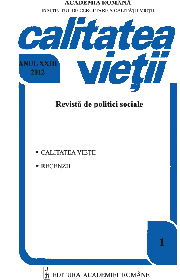Romii argintari – de la ajustarea adaptivă a secolului XX la integrarea progresivă din secolul XXI
Rroma silversmiths – from adaptative adjustment of the 20th century to the progressive integration of the 21th century
Author(s): Oana Banu, Ionela IonescuSubject(s): Social Sciences
Published by: Editura Academiei Române
Keywords: Rroma silversmith; craft products; economy; marginalization
Summary/Abstract: In the current economy, modern and technologically advanced, most specific Rroma population crafts no longer had a place, due to their linkage with obsolete past historical periods. The difficulties in communication, cultural stereotypes and misconceptions of majority represent severe inconveniences in the social and economic integration process of Rroma population. In turn, Rroma crafts pay tribute to these negative stereotypes. The transition to a globalized economy facilitated and enabled competition with manufactures products made in large-scale, which replaced much of the items and handmade goods, crafts, having a devastating impact on traditional Rroma crafts. These crafts are considered by Rroma as low income generators steady and satisfactory, who are tempted to leave behind practice of these traditional jobs even if they are a part of their identity. Silversmiths and other traditional artisans face difficulties caused by the use and adaptability of their crafted products to the needs of the current economy. They realize that the creation of ad-hoc jewelry in front of a real public (as potential direct buyers) makes a significant contribution in assigning economic value to the final product, which increases its economic value and cultural exchange. Besides the idea of uniqueness of product, the method of production of such objects could be considered added value which underline the difference between live artisanal made jewelry and mass-produced silversmiths series, widely available in shops. Research on silversmiths highlighted the cultural and type of their organization, how the crafts are practiced, means of production, markets, the production cycle, ways to promote products, various innovations to the traditional way of execution, financial difficulties/ threats to practicing the craft in the current economy. Silversmiths have difficulties in terms of access to markets, have defective relations with the local authorities, do not have a properly and accessible legislated framework. It’s more advantageous for them to sell their products on the countryside because the taxes are not so high that in Bucharest. Silversmiths producing between 500–600 items per month and participate in one fair from four. The reason behind this situation is, in their opinion, discrimination, lack of involvement of authorities in support of Rroma. When they get approvals to participate in such art fairs, these licenses/ approvals are subject to specula implemented by intermediaries who do not practice the art, but they are selling these licenses. In conclusion, the perpetuation of silversmith crafts to the younger generations would be possible only in conditions of economic attractiveness and profitability, otherwise they will steer in another economic/ job direction.
Journal: Calitatea vieţii
- Issue Year: XXV/2014
- Issue No: 2
- Page Range: 137-160
- Page Count: 24
- Language: Romanian

